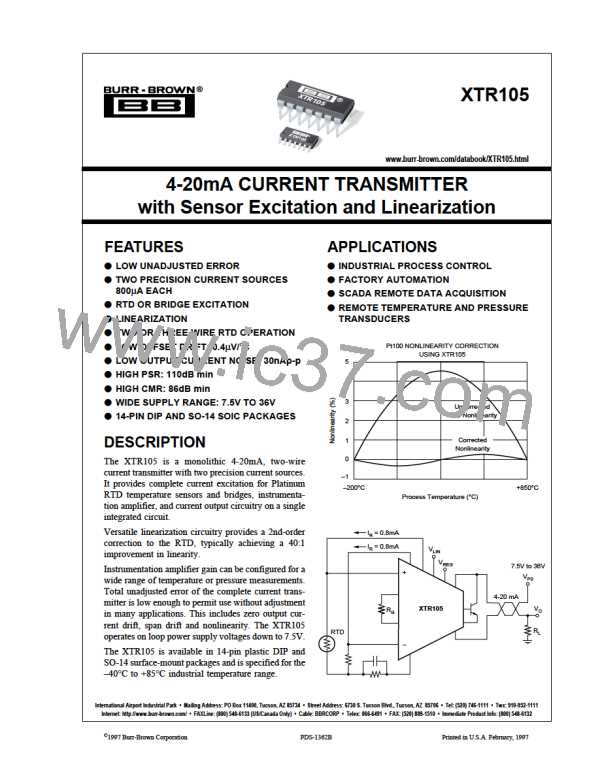A typical two-wire RTD application with linearization is
shown in Figure 1. Resistor RLIN1 provides positive feed-
back and controls linearity correction. RLIN1 is chosen ac-
cording to the desired temperature range. An equation is
given in Figure 1.
RCM can be adjusted to provide an additional voltage drop to
bias the inputs of the XTR105 within their common-mode
input range.
ERROR ANALYSIS
In three-wire RTD connections, an additional resistor, RLIN2
,
Table II shows how to calculate the effect various error sources
have on circuit accuracy. A sample error calculation for a
typical RTD measurement circuit (Pt100 RTD, 200°C mea-
surement span) is provided. The results reveal the XTR105’s
excellent accuracy, in this case 1.1% unadjusted. Adjusting
resistors RG and RZ for gain and offset errors improves circuit
accuracy to 0.32%. Note that these are worst case errors;
guaranteed maximum values were used in the calculations and
all errors were assumed to be positive (additive). The XTR105
achieves performance which is difficult to obtain with discrete
circuitry and requires less space.
is required. As with the two-wire RTD application, RLIN1
provides positive feedback for linearization. RLIN2 provides
an offset canceling current to compensate for wiring resis-
tance encountered in remotely located RTDs. RLIN1 and RLIN2
are chosen such that their currents are equal. This makes the
voltage drop in the wiring resistance to the RTD a common-
mode signal which is rejected by the XTR105. The nearest
standard 1% resistor values for RLIN1 and RLIN2 should be
adequate for most applications. Table I provides the 1%
resistor values for a three-wire Pt100 RTD connection.
If no linearity correction is desired, the VLIN pin should be
left open. With no linearization, RG = 2500 • VFS, where
VFS = full-scale input range.
OPEN-CIRCUIT PROTECTION
The optional transistor Q2 in Figure 3 provides predictable
behavior with open-circuit RTD connections. It assures that
if any one of the three RTD connections is broken, the
XTR105’s output current will go to either its high current
limit (≈27mA) or low current limit (≈2.2mA). This is easily
detected as an out-of-range condition.
RTDs
The text and figures thus far have assumed a Pt100 RTD.
With higher resistance RTDs, the temperature range and
input voltage variation should be evaluated to ensure proper
common-mode biasing of the inputs. As mentioned earlier,
12
IO
1
IR1
VLIN
14
11
IR2
13
VI+N
(1)
(1)
10
V+
RLIN1
RLIN2
VREG
4
RG
R(G1)
9
8
B
E
Q1
0.01µF
XTR105
3
2
RG
VI–N
IO
7
IRET
(1)
EQUAL line resistances here
creates a small common-mode
voltage which is rejected by
XTR105.
RZ
IO
6
2
1
RCM = 1000Ω
0.01µF
(RLINE2
)
(RLINE1)
NOTES: (1) See Table I for resistor equations and
1% values. (2) Q2 optional. Provides predictable
output current if any one RTD connection is
broken:
(2)
Q2
2N2222
RTD
OPEN RTD
IO
TERMINAL
(RLINE3
)
1
2
3
≈ 2.2mA
≈27mA
≈2.2mA
3
Resistance in this line causes
a small common-mode voltage
which is rejected by XTR105 .
FIGURE 3. Three-Wire Connection for Remotely Located RTDs.
®
10

 BB [ BURR-BROWN CORPORATION ]
BB [ BURR-BROWN CORPORATION ]